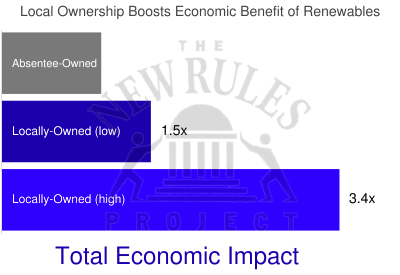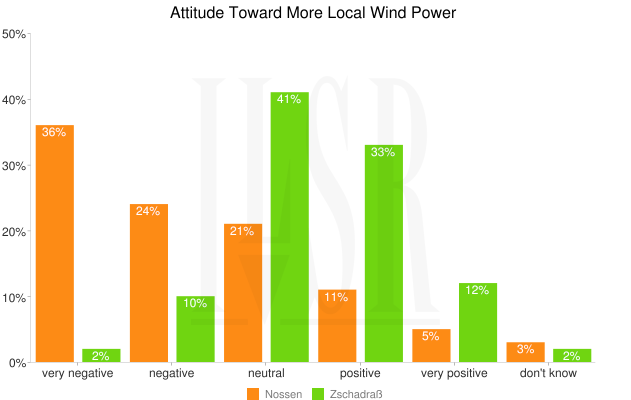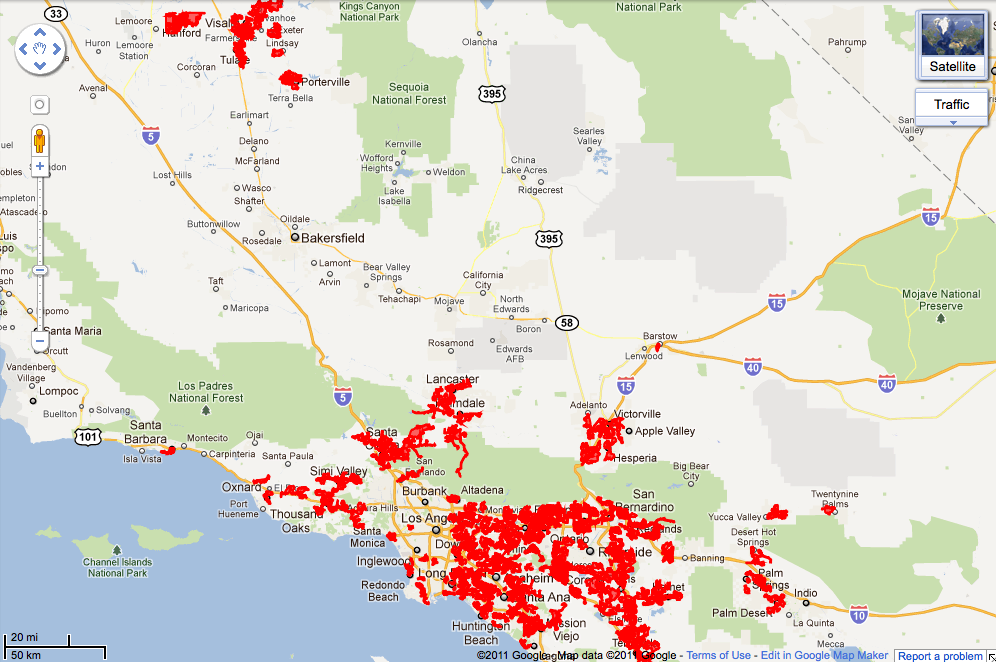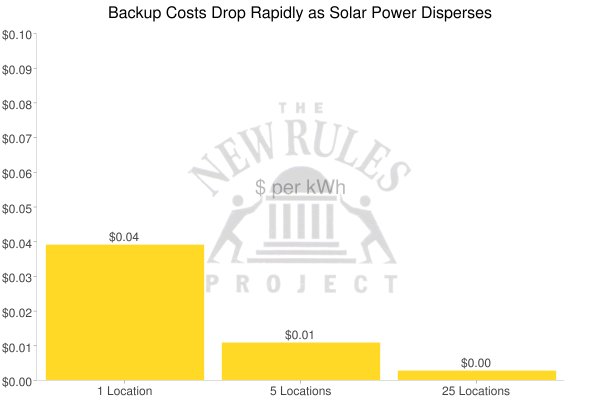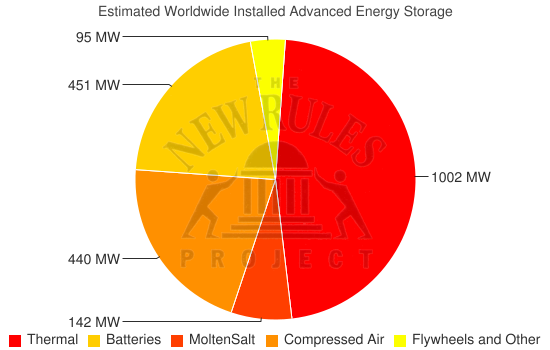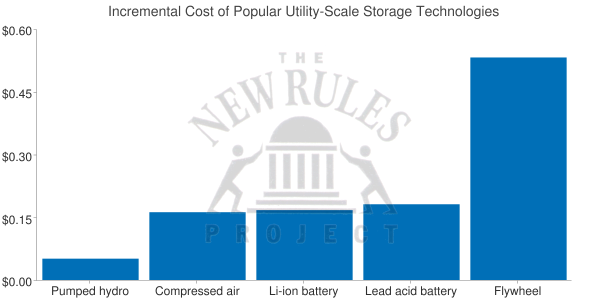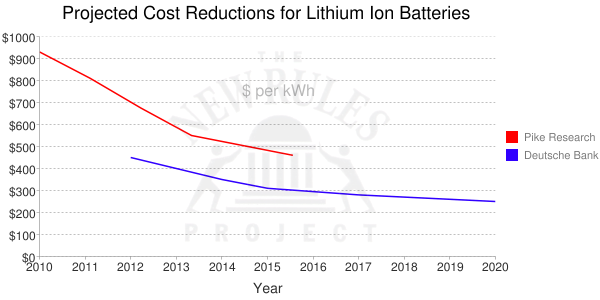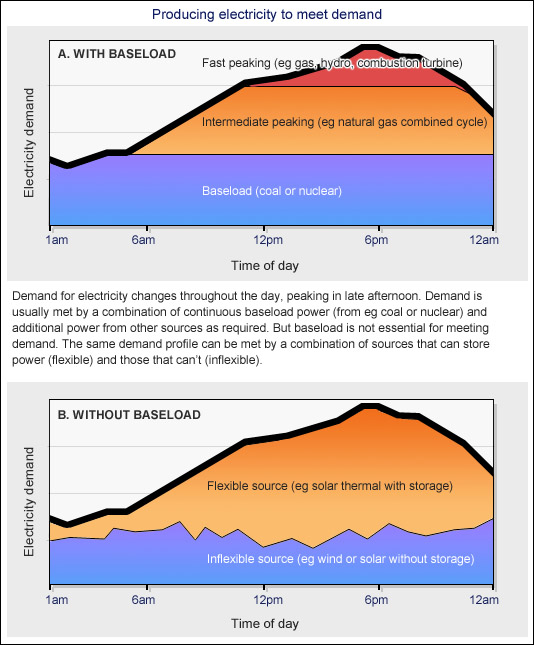The Political and Technical Advantages of Distributed Generation
While technology has helped change the economics of electricity production (in favor of renewables and distributed generation), this new dynamic can as easily be controlled by the incumbent utilities as the old paradigm of centralized fossil fuel power generation.
The cornerstone of the distributed generation revolution is its potential democratizing influence on the electric grid, the opportunity unlocked for local ownership and the coincident political support for more renewable energy. In no place is that clearer than in the public support for renewable energy.
An increasing number of renewable energy projects (primarily wind, but also large-scale solar) have met with resistance from local residents or environmentalists. Centralized, remote generation might seem to avoid NIMBY issues by placing wind turbines or solar power plants far from population centers; but in practice, there have been opponents to these projects as well. Large power plants raise questions about environmental impact from creature habitat to water consumption. Power from distant plants must be transmitted over high-voltage transmission lines to get to load centers without significant losses, and such lines are built only at great ratepayer expense, over many years, and with the taking of land with eminent domain. Some folks just hate the look of power plants, regardless of their sustainable nature.
Resistance has been organized enough to win restrictive state siting policies (e.g. wind policy in Wisconsin) or to coordinate environmental advocacy organizations to oppose solar power plants on undeveloped desert lands. In some cases, resistance takes on the strange aspect of “wind turbine syndrome,” or other mysterious illnesses.
At the heart of the matter, citizens rightly see renewable energy as different, and find it frustrating to see new, widely available resources like sun and wind developed under the old, centralized paradigm and owned by the usual suspects. In a recent study by the ever-methodical Europeans, they found that opponents to new wind and solar power have two key desires: “people want to avoid environmental and personal harm” and they also want to “share in the economic benefits of their local renewable energy resources.”
It’s not that people are made physically ill by new renewable energy projects. Rather, they are sick and tired of seeing the economic benefits of their local wind and sun leaving their community.
Local Ownership Boosts Economic Benefit of Renewables:
Such opposition is perfectly rational, since investments in renewable energy can be quite lucrative (private developers and their equity partners routinely seek 10% return on investment or higher). And the economic benefits of local ownership far outweigh the economic colonialism of absentee owners profiting from local renewable energy resources.
Additionally, when projects are absentee owned, local residents see little to no economic advantage to offset their concerns about health or the environment.
It’s not just centralized renewable energy projects facing opposition; distributed generation (DG) can also face resistance. While DG projects are of a more modest scale than centralized power generation, they also reside closer to actual electricity demand; thus, they are closer to population centers. For solar, this is largely a non-issue, because it can be easily installed on rooftops or other existing structures. Similarly, other technologies like geothermal or even natural gas generate little hostility from locals. On the other hand, for wind power there’s little distinction between a 30 MW and 300 MW project, because all the turbines are the same size. A distributed wind project will place very large turbines close to population centers and wind projects of all sizes have met with stiffer resistance.
For both centralized and distributed generation, local ownership becomes the key to unlocking local support. For example, the following chart illustrates the local support for wind power in two German towns, Nossen and Zschadraß.
Local Ownership Boosts Public Support for Wind (study link):
With local ownership of the wind project, 45% of residents had a positive view toward more wind energy (Zschadraß). In the town with an absentee-owned project (Nossen), only 16% of residents had a positive view of expanding wind power; a majority had a negative view.
By unlocking economic opportunity, distributed generation and local ownership of renewable energy create a positive feedback loop for more investment in renewable energy.
Avoiding Eminent Domain
Distributed generation also avoids one of the major drawbacks to centralized generation: the need for new transmission infrastructure, commonly constructed by seizing land with the power of eminent domain. According to the Federal Energy Regulatory Commission (FERC), there are nearly 15,000 miles of new, high-voltage transmission lines planned to be in service by 2013. With most transmission lines requiring significant right-of-way (200 feet), this is equivalent to 363,500 acres of property needed. A substantial portion that will be taken with eminent domain or negotiated with landowners under the threat of eminent domain.
One issue for many landowners is that their land is taken or easement granted for a one-time payment, while the utility continues to draw revenue from selling access to the transmission line for decades. In Wyoming, landowners have organized to try to change the law to require an annual payment, in part because the transmission lines are being constructed to ferry wind power from Wyoming to places out-of-state.
There are few solutions to the eminent domain challenge, although a bill introduced during the 2009 Minnesota state legislative session would have tried to make the process fairer in that state. Currently, Minnesota utilities are exempt from many of the rules restricting how local government entities can use eminent doma
in. Utilities, unlike governments, do not have to negotiate in good faith, are not required to show landowners any appraisals of their property and do not have to compensate businesses for losses stemming from a forced change of location. The proposed legislation (which failed) would have harmonized the rules for utilities and local governments, and made eminent domain for transmission fairer.
Distributed Generation and the Grid
While the distributed generation transformation of the grid is a political and economic one, the process also involves a significant paradigm shift in the operation and physical nature of the grid, as well. In the short run these challenges are minimal, and in the long run they are surmountable.
Integration of Distributed Generation
The spread and growth of solar PV and other distributed renewable energy in the United States has led to significant modeling and engineering analyses of distributed generation and the grid. The data shows that previous conventions may have been wrong, and that the grid is capable of absorbing significant amounts of distributed solar and other technologies without significant harm.
 California, the leader in PV installations, has done the most modeling and empirical work on integrating distributed generation. Utilities in California generally agree that 15% distributed generation on a local distribution circuit is the threshold for any problems. This figure is reinforced by a distributed generation technical study in Nevada that suggested no significant impacts on the distribution network when distributed generation is 15% or less of the total generation. For reference, 15% of California’s peak summer demand would be equivalent to around 7,500 MW of distributed generation, more than is currently on the state’s grid, and much more than is present on the grid system in any other U.S. state.
California, the leader in PV installations, has done the most modeling and empirical work on integrating distributed generation. Utilities in California generally agree that 15% distributed generation on a local distribution circuit is the threshold for any problems. This figure is reinforced by a distributed generation technical study in Nevada that suggested no significant impacts on the distribution network when distributed generation is 15% or less of the total generation. For reference, 15% of California’s peak summer demand would be equivalent to around 7,500 MW of distributed generation, more than is currently on the state’s grid, and much more than is present on the grid system in any other U.S. state.
Some studies are more conservative. A 2001 study by the Electric Power Research Institute suggested that integrating distributed resources larger than 500 kW on distribution feeders would require “utility system changes.”
Other studies and experiences suggest that the 15% convention may be too conservative.
However, a study by the California Energy Commission showed that over two-thirds of California substations could handle distributed projects of 10 MW or smaller. Also, distribution feeders could handle new generation of 15 to 50% of capacity depending on its distribution along the line, with higher percentages possible with smart grid and energy storage improvements.
In total, the Commission study suggested that the state’s grid system could handle 75,000 MW of distributed generation (under 20 MW) at the substation level and 113,000 MW (of sub-3 MW projects) at the distribution feeder level, far more than actual peak summer demand. Even in the short term (prior to 2020), the California grid system could handle enough DG to fill half of the resource gap toward the proposed 33% renewable standard.
| California Independent System Operator: No new backup needed to reach 33% renewables by 2020. |
|---|
A recent modeling exercise by the California Independent System Operator suggests that no new “flexible” (backup) generation will be needed to support renewables for the state’s aggressive 33% by 2020 target.
Several sites in the U.S. also offer anecdotal evidence that significant quantities of distributed generation will not be problematic:
| Las Vegas, NV, has over 10,000 kW of commercial solar PV on a 35 kV interconnection (50% of capacity, 100% during low load) with no reported issue. |
|---|
- Kona, HI, has a 700 kW solar array that is 35% of the capacity of its distribution feeder, with no reported issues.
- Lanai, HI, has a 600 kW solar array that is 12% of distribution circuit capacity (25% during low load), with no reported issues.
- Anatolia, CA, has 238 kW of residential PV (4% of capacity, 13% during low load) with no reported issues.
- Las Vegas, NV, has over 10,000 kW of commercial solar PV on a 35 kilovolt (kV) interconnection (50% of capacity, 100% during low load) with no reported issues.
- Atlantic City, NJ, has 1,900 kW of commercial solar PV on a 23 kV interconnection (24% of capacity, 63% during low load) with no reported issues.
The strongest evidence may be from Europe, where distributed generation on the grid has already far exceeded the most robust distributed generation markets in the U.S. In Germany, with over 15,000 MW of PV (99% of it distributed generation), there have been no significant issues even though PV can at peak times meet 20% of peak demand (and German wind power, half in projects 20 MW and smaller, can meet nearly twice that at peak). Spain has 3,400 MW of distributed PV, enough to meet 15% of peak demand during the sunniest periods, and again without significant grid issues.
In a recent article on the Renewable Energy World website, Kelly Foley of Vote Solar suggested that the issue is not adding variable distributed energy generators, but rather grid protocols that enforce a paradigm of a centralized grid based on large, inflexible power stations. She notes that hourly scheduling and a fleet of gas turbines provide the regulatory and backup power required by centralized coal and nuclear power production, and that similar strategies could minimize any grid impacts from variable distributed resources.
By separating the impacts of solar variability due to the daily movement of the sun (called DMV – diurnal movement variability) from the weather change impacts (WBV – weather based variability), grid planners can begin to address their intermittency concerns. The former is predictable and known, such that it can be addressed ex-ante, meaning that its grid impacts can be effectively eliminated in a least cost manner. The latter, WBV, however, is more likely to require ex-post solutions, such as requiring grid operators to consider solar generation on a fleet wide basis, rather than assessing performance on each individual unit. Thus, while WBV cannot be entirely avoided, it can certainly be significantly minimized.
Again by way of example, the current California Public Utilities Commission (CPUC) long-term planning proceeding does not distinguish DMV and WBV from each other. This lack of separation could potentially cause the CPUC’s integration model to overestimate the amount of new gas resources needed to firm, follow or back-up solar generation.
[emphasis added]
Utilities are also developing (with regulatory nudging) public information access to their distribution grids. The interactive maps allow prospective developers to identify areas on the distribution system where their project can connect with a minimum of interconnection costs. Southern California Edison (SCE), for example, provides a map with this notification:
Based on initial screening studies, locating your [solar] project inside one of the identified areas could potentially minimize your costs of interconnection to the SCE system.
San Diego Gas & Electric (SDG&E) was required by the public utility commission to acquire 74 MW of solar via competitive solicitations and “create an interactive mapping w
ebsite where Respondents can visit to obtain circuit-level information. Respondents can zoom to areas of interest to see circuit feeder routes and available capacities of the feeders. In addition, SDG&E will provide spreadsheets indicating available capacities of substations and circuits in local communities served by SDG&E.”
Challenges remain for evaluating the impact of distributed generators on the electrical grid. In a 2010 study for the California PUC, the authors note that, “there are currently no distribution planning models that can accurately simulate the interaction of PV components such as the inverters with substation equipment.”
Thus, research continues. A number of regulatory agencies and utilities are continuing to explore the impact of high quantities of distributed generation on utility grid systems:
- The National Renewable Energy Laboratory released a study in 2010 showing the technical potential for the western U.S. electric grid to integrate 35% wind and solar power.
- The U.S. Department of Energy is doing a study of the impacts of large solar PV quantities on the distribution system.
- An electric utility on the Hawaiian island of Kauai is testing a high penetration scenario for solar PV. A 1.2 MW solar farm has a peak load identical to the local circuit and has so far caused no major problems.
The Grid Benefits of Distributed Generation
While utilities have yet to experience serious issues from distributed solar generation, they are already experiencing benefits to the grid.
| Distributed solar power has value to the grid (above the electricity produced) of 14 to 30 cents per kilowatt-hour. |
|---|
Distributed solar power provides electricity on-site or near to demand, reducing transmission losses, as well as wear-and-tear on utility equipment by mitigating peak demand. It also eliminates the need to hedge against fuel price swings. A recent study found that these benefits add 3 to 14 cents per kWh to the utility bottom line.
Distributed solar also provides value to society, by reducing the economic losses of blackouts (just 500 MW of distributed solar could have prevented the massive 2003 Northeast blackout), reducing pollution and greenhouse gas emissions, hedging against finite fossil fuel supplies, and creating jobs. These benefits add 11 to 16 cents to the taxpayer’s bottom line for every kWh of distributed solar. Combined, distributed solar power has value to the grid (above the electricity produced) of 14 to 30 cents per kilowatt-hour.
In a CPUC study, the researchers found that, “As a result of the local PV generation, electrical heating losses on the PG&E distribution circuits analyzed were reduced from 1.7-2.4% at the time of peak circuit loading.”
| The value of solar PV to the grid reflects its high capacity factor during hours of peak demand. During peak periods in California, solar produces close to 60% of its rated capacity. |
|---|
The study concluded that PV reduced peak demand on a distribution line by 0.35 kW for every kW of “rebated PV,” and reduced peak demand on transmission lines by 0.3 kW for every kW of “rebated SGIP capacity.” Rebated capacity reflects the system size that received a cash rebate and may be less than the system’s nameplate capacity. The value of solar PV to the grid reflects its high capacity factor during hours of peak demand. Solar delivers close to 60% of its rated capacity during the entire peak demand period, e.g. hot, sunny days.
In two recent decisions (described below), the CPUC has estimated the value of distributed generation to the grid system in terms of avoided infrastructure costs.
In the first – a hearing before the Federal Energy Regulatory Commission on California’s standard offer program for combined-heat-and-power (CHP) producers – CPUC asserted that, “for CHP systems located in transmission-constrained areas, there should be a 10 percent price adder to reflect the avoided costs of the construction of distribution and transmission upgrades that would otherwise be needed.”
The cost savings from distributed generation are not restricted to transmission-constrained areas. In its second decision – to establish a Renewable Auction Mechanism (RAM) to develop 1,000 MW of distributed generation – the CPUC emphasized that the concerns of investor owned utilities (IOUs) about needing additional transmission infrastructure were unfounded.
IOUs argue that such an expansive approach will increase costs by necessitating construction of additional transmission and distribution (T&D). We are not persuaded.
CPUC noted that the short timeframe of the auction would minimize demand for new infrastructure and that developers would have to share those (reasonable) costs. Finally, CPUC challenged the utilities’ assertion than there are large bulk power transfers burdening their transmission networks. Rather, these exchanges are largely on paper.
A California Energy Commission working group on distributed generation estimated that distributed generation created avoided capacity costs of $34 per kilowatt-year on both the distribution and sub-transmission systems (based on the avoided cost savings from energy efficiency measures of similar capacity). Presumably this is because on-site generation is treated as load reduction.
Cost savings from distributed solar were also found in a study for the Austin, TX, municipal utility. While the energy value of the solar power was only around 7 cents per kWh (the value of the electricity it would displace), the available capacity, deferral of grid infrastructure upgrades and avoidance of delivery losses (e.g. transmission) added significantly to the value of PV to the utility as shown in the chart to the right.
Distributed PV Has Non-Electricity Value, Too:
Another study by Arizona Public Service will put 1.5 MW of distributed solar PV on a single distribution feeder in order to more clearly identify the integration costs of distributed generation and its unique value to the grid.
Backup & Storage
In the short run, the major challenge for distributed generation is the variability of renewable energy. This problem can be mitigated in part by using more distributed generation. Using solar as an example, a single solar PV power plant has backup costs for the utility of around 4 cents per kWh (to have other power plants available to cover variations in output). However, if 25 solar power plants are dispersed across a broad region (e.g. a metropolitan area), these backup costs fall by 93 percent, to far less than a penny pe
r kWh.
Dispersing Solar Cuts Backup Costs Dramatically:
Dispersing wind power generation has similar impacts, albeit requiring a larger geographic area.
The good news is that, as more and more technical research is completed, the findings are consistently showing that the amount of backup power (e.g. spinning reserve) decreases as more distributed renewables are put in place and as the grid is made “smarter.” The bad news is that we don’t yet have a lot of experience from which to draw conclusions. Most of the research has focused on the impacts of bringing in dispersed wind energy and there has been less study of integrating large amounts of distributed solar projects into the grid. That dynamic is starting to change as more states are poised to bring substantial quantities of distributed solar energy projects onto the grid in the coming years.
Once again, the Europeans are leaders. Their experiments with “virtual power plants” – essentially, using information technology to coordinate decentralized renewable energy generators on a smart grid – are reducing the need for traditional fossil fuel backup power and increasing the efficiency of networked renewable energy generators.
In the long run, distributed and variable renewable energy generation will become a more significant portion of the electricity grid, and the existing system will not be able to smoothly accommodate this new generation without changes.
A Future with Natural Gas?
Many renewable energy advocates are convinced that the grid will adapt largely by introducing more natural gas generators, able to cycle quickly to accommodate fluctuating production from wind and solar power plants. General Electric has even developed a new natural gas turbine with the purpose of more effective backup to variable renewable energy sources.
There’s also a surprisingly substantial amount of emergency and on-site backup available that may be more useful to a distributed grid. In 2003, distributed power systems comprised 200 gigawatts of capacity and generated 6 percent of total U.S. electricity. Most were used for emergency backup, and only 10-15% of these systems were connected to the grid. But there may be an opportunity to tap these systems to integrate more variable, renewable distributed generation.
As the quantity of renewable energy generators rises further, energy storage may play as much or more of a role than backup generation. Today in the United States about 2.5% of total electricity is provided through energy storage technologies. The vast majority comes from pumped hydroelectric projects. Along with pumped hydro, compressed air energy storage and advanced lead-acid battery storage are the most widely pursued by utilities.
Estimated Worldwide Installed Advanced Energy Storage (CA Energy Storage Alliance):
Until variable renewable energy sources become a bigger portion of grid energy, storage will serve many other applications than just being a tool to store kilowatt-hours for another time (“time-shift”). A 2010 report for Sandia National Laboratory provides a categorization of major energy storage applications, ranging from “voltage support” to “transmission congestion relief.”
This variety of applications for energy storage is also relevant to the cost of storage. While the cost of advanced batteries and other storage technologies is relatively high, the California Energy Storage Association notes that storing electricity like a battery is only a fraction of the full potential value of an energy storage system.
If an energy storage system (e.g. a big battery) were used to replace a natural gas “peaker” plant (used when electricity demand peaks), the adjacent chart illustrates the many other valuable benefits the battery system would provide.
Energy Storage is More Than Big Batteries (CA Energy Storage Alliance / Greentechmedia):
The high value of energy storage in a variety of applications means that it can be worthwhile even at relatively high cost per kW compared to new fossil fuel or renewable energy generation. Costs (and benefits) can vary quite a bit even for a given technology (e.g. batteries, compressed air energy storage, flywheels) as well as for a given application (e.g. voltage support, energy time shifting, firming renewable energy).
The following table shows energy storage costs from the Electric Power Research Institute, comparing that to installed costs for renewable energy and natural gas combined cycle power plants.
| Technology | Cost per kW |
|---|---|
| Compressed air | $810 to 1,045 |
| Lead-acid battery | $2,000 to 3,000 |
| Lithium-ion battery | $1,200 to 4,000 |
| Solar PV | $3,500 |
| Onshore wind | $2,000 |
| Natural gas | $1,000 |
Translated to a per kWh cost, the following chart illustrates the incremental cost of storage (added to the initial cost of generating a kWh of electricity) as estimated by Glenn Doty of Doty Energy.
Incremental Cost of Popular Utility-Scale Storage Technologies (Glenn Doty):
Pumped hydro, for example, adds about 5 cents to each kWh that is stored. Other technologies are more expensive.
Utilities are gaining practical experience managing variable generation with storage. Denmark relies heavily on pumped hydro storage in Norway to help them manage their wind power that can at times generate more than 100% of current demand. Alabama’s Electric Cooperative has been operating a 110 MW compressed air energy storage system since 1991.
Xcel Energy has been testing a 1-MW (7.2 MWh) sodium-sulfide battery that is integrated with a 11.5-MW wind energy project in Luverne, MN. The Long Island Power Authority in New York is considering a 400 MW battery storage facility to meet new demand by shifting excess night-time generation to daytime load.
In the near term, some storage technology costs will decrease significantly, according to the Electric Power Research Institute (EPRI). Their forecast is reinforced by the history of price reductions of lithium ion bat
teries in consumer electronics (below). The red line (with square markers) illustrates the falling cost of consumer lithium ion batteries per Watt-hour and the blue line (with diamond markers) shows the increasing energy density of the batteries, in Watt-hours (Wh) per kilogram (kg).
Historical Cost Reductions for Consumer Lithium Ion Batteries (David Anderson):
EPRI anticipates that larger-scale lithium ion battery costs will drop, too, as the electric vehicle industry ramps up. Other industry experts are also forecasting significant decreases in lithium ion prices. The following chart shows the price forecasts for lithium ion batteries for use in electric vehicles from Pike Research and Deutsche Bank.
Projected Cost Reductions for Lithium Ion Batteries:
Also in the near term, underground compressed air storage and pumped hydro systems should see lower costs on a per kW basis as additional projects come online. However, there is also uncertainty in compressed air cost projections with the primary constraint being identifying developable sites, environmental permitting, and available nearby transmission assets.
As costs fall and renewable energy grows, energy storage will play an increasingly important role in smoothing integration of distributed generation into the electricity grid.
Smart grids
Smart grid is a poorly defined term, but the basic concept is a grid that maximizes information and automation to operate at peak efficiency. The improvements range from the central and distributed generator through the high-voltage transmission network and the distribution system, to industrial users and building automation systems, to energy storage installations, and to end-use consumers and their thermostats, electric vehicles, appliances, and other household devices.
The technologies of smart grid are grid paradigm neutral. Tools like advanced meters, robust real-time price signals, and two-way power flow control could democratize the grid so that energy consumers could become more energy efficient and also be energy producers. The tools of the smart grid could also make a top-down grid operate more efficiently. For example, a citywide smart grid rollout by the Chattanooga, TN, public utility uses smart meters and automated switches and is forecast to reduce outage time by 40% and provide demand side reduction of 15%, as well as improve power quality.
Smart grid information flow could clearly be an advantage in integrating distributed generation, but so far few U.S. utilities are seeing this technology upgrade in that light.
A Long-Term Paradigm Shift
Electricity planning is based on 20-30 year predictions. Today, distributed generation is a very small part of our electricity presence. But assuming that current growth rates continue, within 20 years it will be a significant presence. Today planners are grappling with the question of how to integrate growing amounts of DG into grid system based on centralized generation and long distance transport of electricity. Future planners may grapple with the reverse: how to integrate centralized generation into a grid comprised primarily of distributed generation and storage.
Right now, the grid is based on meeting electricity demand by stacking power plants, as shown in the adjacent graphic. The lowest layer are coal and nuclear power plants. They are called “baseload” because they are run almost all the time at the highest possible capacity. The next layer are called intermediate because they ramp up production as demand (load) increases and ramp down as it decreases (e.g. up in daytime, down at night), but not as quickly as the top layer. The top layer of power plants are called “fast peaking” because they respond on short notice to peaks in power demand (such as air conditioners running overtime on very hot summer days).
A Paradigm Shift in Electricity Supply (David Mills/ABC News)
One problem for distributed generation integration is that long term power supply contracts from centralized baseload resources (e.g. coal) can cause variable (solar and wind) resources to be curtailed if there is no local load and no excess capacity on the grid. Thus today and in the short run, new renewables displace intermediate and peaking plants such as hydro generators or natural gas plants.
As more and more variable resources are interconnected, they will compete more directly with central station, baseload power plants in supplying our instantaneous energy needs. At this point, engineering challenges begin. Nuclear power plants can change output by up to 5% of total capacity on a minute-to-minute basis, but only if the power plant is already operating at a minimum of 50 to 60% of full capacity. For any baseload power plant, there are increased operations and maintenance costs associated with frequent adjustments to output.
As the nature of the grid changes, it will make more sense to change the nature of electricity planning rather than cramming variable, distributed generators into a centralized baseload plus peaking paradigm. For example, long-term planning processes need to effectively differentiate variability based on weather (clouds and wind) from variability based on time of day or season. As noted above, in a proceeding before the California Public Utilities Commission, one intervenor noted that without differentiating seasonal from daily variability, utilities will overestimate the amount and cost of backup generation needed to support distributed generation.
Solar and wind have no fuel cost, so they can always outbid fossil fuel power on the spot market. Instead of matching demand by stacking intermediate and peaking plants on top of baseload power plants, the new grid will take all available renewables first and then use demand management, storage, and intermediate/peaking fossil fuel power plants to match supply with demand. Unlike the current system of primarily inflexible generators, the new flexible grid will more easily accommodate the electricity generated at any given moment as wind and solar output changes based on wind speed and/or cloud cover.
In Germany, the tension between distributed and centralized electric paradigms has become intense as renewable energy – primarily distributed generation – has reached 17% of supply (up three-fold in a decade), peaking at over 30% at times.
Dr. Norbert Rottgen, German Federal Minister for the Environment, thinks Germany and in the future the United States, will have to make a choice.
It is economically nonsensical to pursue two strategies at the same time, for both a centralized and a decentralized energy supply system, since both strategies would involve enormous investment requirements. I am convinced that the investment in renewable energies is the economically more promising project. But we will have to make up our minds. We can’t go down both paths at the same time.
When we make additional investments
in the electricity grid, we should no longer be spending money on the 20th century grid system, but should instead focus on the 21st century paradigm of distributed generation. The centralized model no longer fits the inherently decentralized nature of renewable energy supply and the economic and democratic advantages of distributed generation. The grid must change.
To read more about democratizing the electricity system, click through:
- Part 1 (The Potential for Distributed Generation)
- Part 3 (The Political and Technical Advantages of Distributed Generation)
- Part 4 (Regulatory Roadblocks to Democratizing the Electricity System)
- Part 5 (Overcoming the Roadblocks to Democratizing the Electricity System)
- Download the full report.The Political and Technical Advantages of Distributed Renewable Power

